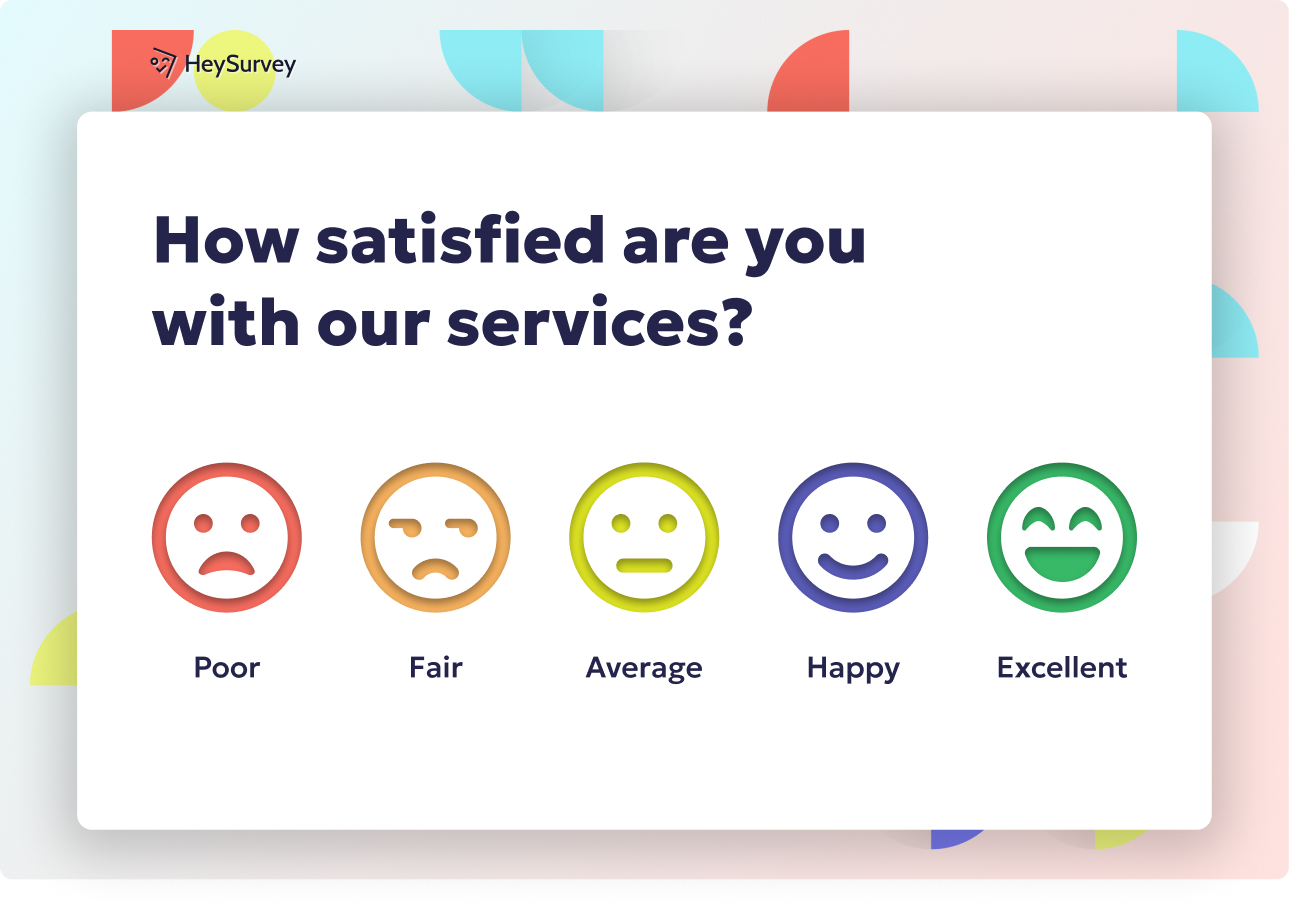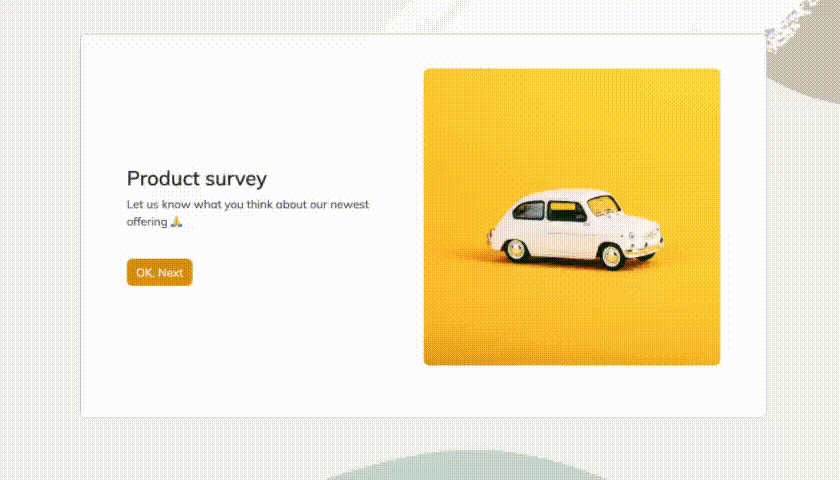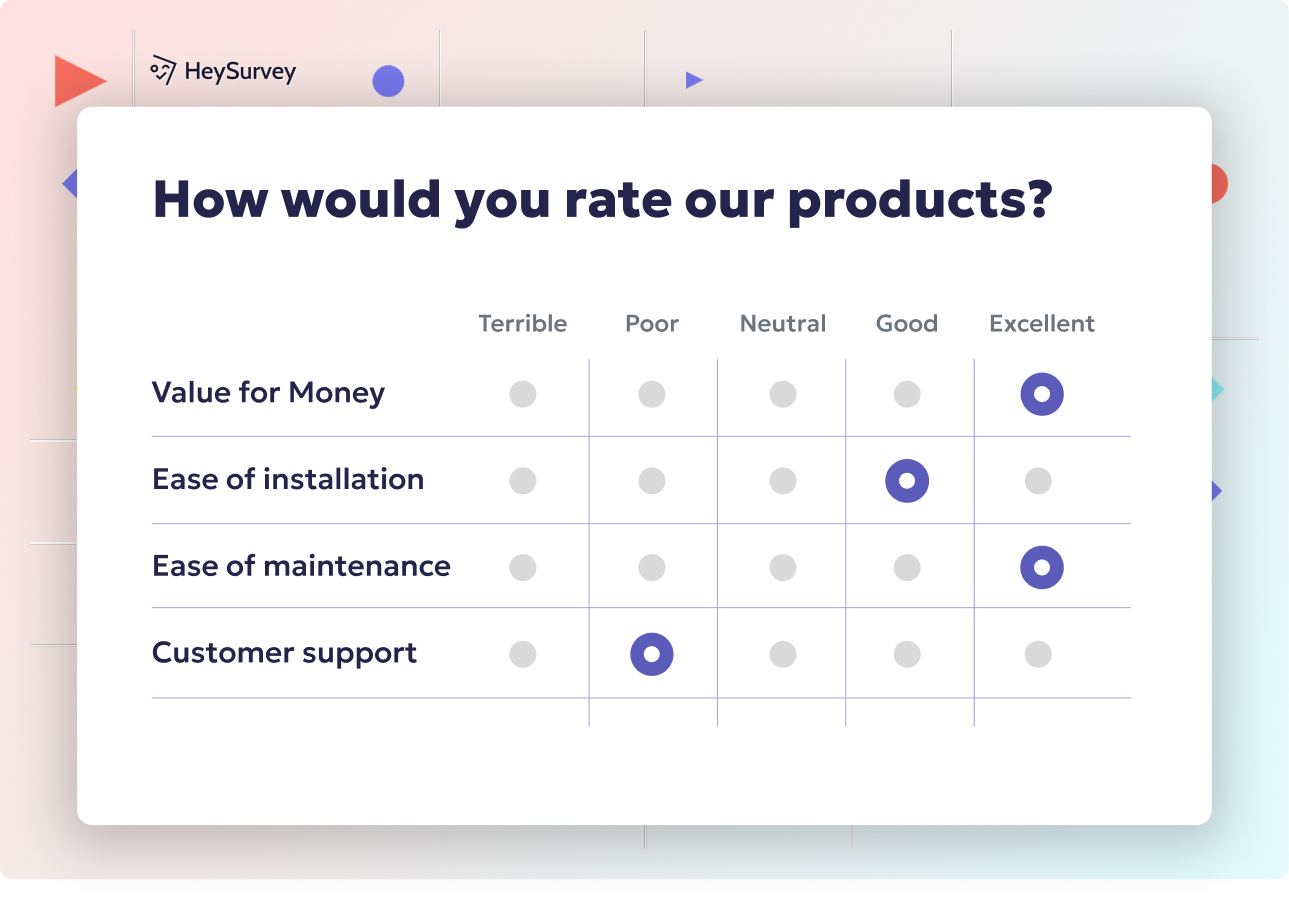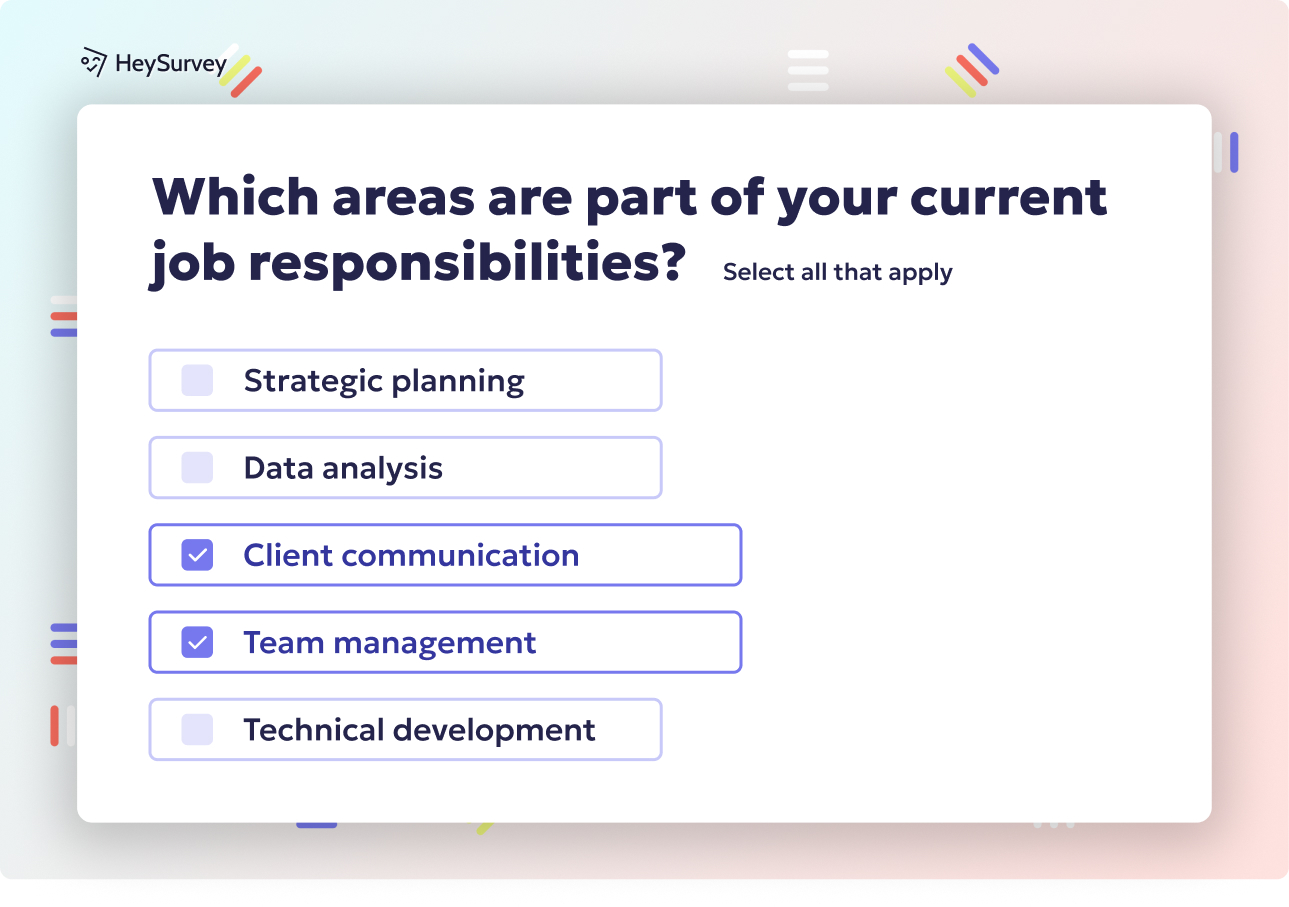30 Community Engagement Survey Questions: Types & Examples
Explore 25+ proven community engagement survey questions across types to boost participation, gather feedback, and prioritize local needs.
Community engagement surveys are powerful tools for anyone trying to boost community participation and make real, positive change. Whether you’re working in a city office, a nimble nonprofit, or a grassroots group, these surveys help you strengthen relationships, set smart priorities, and keep progress on track. They help you ramp up awareness, fine-tune events, identify burning needs, and build stronger partnerships. In this guide, you’ll find the best types of community engagement survey questions, learn exactly when to use them, get plug-and-play examples, and pick up proven tips to maximize both your response rates and the quality of the insights you gather.
Community Awareness & Perception Surveys
What is a Community Awareness & Perception Survey?
Community perception surveys are all about finding out what people actually know—and think—about your group, program, or cause. These surveys let you measure community perception, uncovering everything from basic awareness to subtle (and sometimes hilarious) misconceptions. Are you famous? Are you forgotten? These surveys give you the answers, with data to back it up.
Why & When to Use This Survey Type
When should you bust out the awareness survey questions? Here’s when they really shine: - Before you launch a new project, so you can see if the community is “in the know.” - When you’re rebranding, and need to spot stubborn old impressions that just won’t budge. - Any time you want to measure whether your messaging is actually sticking year after year.
These surveys are perfect for organizations looking to check public reputation, design better marketing strategies, and make messaging more relatable.
Sample Questions
- How familiar are you with [Organization/Program Name]?
- What three words come to mind when you think of [Organization/Program Name]?
- Where do you usually hear about our activities or events?
- Before this survey, had you ever attended or participated in any of our events?
- What is one thing you wish you knew about us that you don’t already?
- Have you noticed any changes in [Organization/Program Name] over the past year?
- On a scale of 1–5, how positively do you view our work in the community?
Interpreting the Data for Messaging Tweaks
Once the responses roll in, use them to sharpen your messaging. If people aren’t clear about who you are or what you do, that’s your cue to clarify your value proposition. If certain words pop up often (positive or negative), weave the positive ones into your promotions and address the negatives head-on. Awareness surveys aren’t just a report card—they’re your cheat sheet for becoming unforgettable.
Effective community engagement surveys should combine open- and closed-ended questions, maintain neutral language to avoid bias, and ensure accessibility across various formats to maximize inclusivity. (commonplace.is)

Creating your community engagement survey with HeySurvey is as easy as 1-2-3! Here’s a simple guide to get you started fast:
Step 1: Create a New Survey
- Head over to HeySurvey and choose “Create New Survey”.
- Pick either a blank template to start from scratch or load a pre-built template tailored for your survey type.
- Give your survey a clear internal name so you can find it easily later.
Step 2: Add Questions
- Click the “Add Question” button at the top or between questions to insert your first question.
- Choose the question type that fits best: text, choice, scale, or others.
- Type your survey questions, add descriptions if needed, and decide if the question is mandatory by toggling “required.”
- Repeat to add all your community engagement survey questions that match your goals.
Step 3: Publish Your Survey
- Hit the “Preview” button to see how your survey looks on desktop and mobile.
- Once satisfied, click “Publish” to finalize your survey and generate a shareable link.
- Share that link with your community via email, social media, or embed it on your website.
Bonus Step 1: Apply Branding
- Visit the Branding or Designer Sidebar panel to upload your logo, set colors, fonts, and background images that match your organization’s style.
- A branded survey builds trust and lets respondents know your survey is legit—and a little fancy never hurts.
Bonus Step 2: Define Settings
- Open the Settings Panel to set start and end dates and limit the total number of responses, if you wish.
- Customize your thank-you page or redirect URL after someone finishes the survey and decide if results should be visible to respondents.
Bonus Step 3: Use Branching Logic
- Want to personalize the path respondents take? Assign branching rules so the next question changes based on earlier answers.
- Branching keeps surveys relevant and breezy, avoiding overwhelming your audience with irrelevant questions.
Ready to dive in? Just click the template button below and kick off your survey creation journey with HeySurvey. It’s quick, simple, and will have you gathering valuable community feedback in no time!
Participation & Attendance Surveys
Why Do Participation & Attendance Surveys Matter?
Every organization wants wall-to-wall crowds and maximum buzz, but without the right event participation survey, you’re just guessing what actually motivates people to show up. These surveys dig into what boosts turnout (or drags it down), helping you understand both motivators and obstacles to attendance. Get ready to diagnose low attendance or celebrate your sold-out success.
Why & When to Use
Whip out attendance feedback questions at key moments to pump life into your programs: - Immediately following major events, to capture fresh (possibly unfiltered) impressions. - During the planning phase for future events, to forecast turnout and adjust accordingly. - Whenever turnout at your meetings, workshops, or classes seems stuck in a rut.
Use these insights to make crucial decisions: scheduling, venue size, and even which social channels deserve your attention or ad dollars.
Sample Questions
- What motivated you to attend this event?
- How did you find out about this event?
- What, if anything, kept you from attending previous events?
- Was the event held at a convenient time and location for you?
- What would encourage you to participate in more of our programs?
- Did you bring friends or family? Why or why not?
- How would you rate your overall experience?
Linking Results to Program Improvements
Review the data and let it guide updates to your event calendar, marketing, and even snacks at the door. If evenings score big, clear your afternoon schedule. If “hard to get there” is a frequent grumble, rethink your venue. Channel the insights from your event participation survey directly into action—and watch your numbers climb.
Research indicates that offering financial incentives, such as checks instead of gift cards, can effectively boost participation in community engagement surveys, especially in areas with limited retail options. (liebertpub.com)
Volunteer Engagement Surveys
What Are Volunteer Engagement Surveys?
When you need to know whether your volunteers are fired up or just showing up, these surveys come to the rescue. They track volunteer satisfaction, motivations, and risk factors so you can keep volunteers engaged (and happy). Volunteers are the lifeblood of most community efforts—don’t let their enthusiasm fizz out!
Why & When to Use
Put a volunteer satisfaction survey into play: - Every year, to track satisfaction trends and growth. - After a big project wraps up, as part of your “thank you” (and reality check). - If you start seeing more “sorry, I can’t make it” responses (aka, time to fix something!).
These surveys are also useful when you want to celebrate wins, spot gaps in training, or overhaul your recognition programs.
Sample Questions
- How satisfied are you with your volunteer experience?
- What motivated you to start volunteering with us?
- Which skills do you use most in your volunteer role?
- Do you feel appreciated for your contributions?
- How likely are you to recommend volunteering with us to a friend?
- What improvements would make volunteering more enjoyable?
- Are there any new roles or tasks you would like to try?
Using Insights to Improve the Volunteer Experience
The survey results can be gold for refining orientation, matching jobs to people’s skills, and giving big thank-yous where they’re due. Take the time to actually act on feedback and announce changes. Volunteers who see their input make a difference are much more likely to stay—and to bring their friends next time.
Communication Channel Preference Surveys
Why Are Communication Preference Surveys Awesome?
Wondering if your community prefers emojis in SMS, artsy Insta stories, or a good old-fashioned email? Communication preference surveys are here to help you reach your community through the channels they actually use. No more shouting into the void!
Why & When to Use
Start asking communication preference survey questions: - When email open rates drop or posts fall flat on social media. - Before you spend serious cash on slick new comms tools or mailers. - Anytime you’re segmenting lists by age group, interest, or location for personalized outreach.
Finding out which channels truly work stops you from wasting time (and money) and helps everyone stay in the loop, their way.
Sample Questions
- How do you prefer to receive updates from us? (Email, SMS, social media, phone, print, in-person)
- Which social media platforms do you use most frequently?
- How often do you want to receive news or updates?
- What type of content do you enjoy most (event info, success stories, volunteer needs, policy updates)?
- Are you comfortable receiving texts from our organization?
- Would you like to participate in live Q&A sessions or webinars?
- What’s the best way for us to contact you about urgent matters?
Segmenting & Personalizing Outreach
Once you have the results, break your lists into smaller groups for hyper-personalized outreach. You might find students want short, snappy TikTok clips while retirees love friendly phone calls. Use that knowledge to tailor your campaigns, boost engagement, and get your message out with surgical precision.
A 2024 survey found that 66% of English-speaking residents prefer email for receiving information from their local government. (publicinput.com)
Community Needs & Priority Surveys
What Are Community Needs & Priority Surveys?
The gold standard for finding out what your community actually needs right now (versus what you think they need). These surveys help you dig deep into unmet needs, resource gaps, and urgent priorities across areas like safety, health, education, and more. If you want to make a real impact, you need direct answers to these questions.
Why & When to Use
Deploy community needs assessment questions: - At the start of strategic planning sessions. - When divvying up resources or creating budgets. - While writing grant proposals or lobbying for policy changes. - After a major community change, crisis, or new development.
This ensures your efforts stay targeted, relevant, and fundable—no more flying blind!
Sample Questions
- What do you see as the top three priorities facing our community?
- Are there any local services or resources you currently lack but would use?
- How satisfied are you with current community safety, health, or recreation programs?
- What suggestions do you have for improving our neighborhood?
- Which age groups or populations do you feel are underserved?
- How well do you feel community leaders listen to local concerns?
- What’s one change you would make if you had a magic wand?
From Data to Action
Take these insights and use them to identify local priorities for planning, advocacy, and grant proposals. The more visible your follow-through, the more likely people are to keep sharing honestly next time. Make it a point to update your community about the changes you’re making based on the feedback—nothing builds trust quite like quick, visible action.
Partnership & Collaboration Surveys
Why Use Partnership & Collaboration Surveys?
No organization is an island. These surveys zoom in on your relationships with local nonprofits, businesses, schools, and public agencies. Think of them as your toolkit to spot win-win partnerships and discover joint program opportunities for maximum impact.
Why & When to Use
Use collaboration survey questions: - When you’re considering a coalition or shared campaign. - After completing a joint project, to see what worked and what (oops) definitely didn’t. - When a grant requires proof of community partnership or you’re pitching a new collaboration.
These surveys are crucial for mapping out common goals, measuring satisfaction in partnerships, and identifying ways to improve future collaborations.
Sample Questions
- How would you rate the communication between our organizations?
- What joint initiatives or resources have been most beneficial?
- Where do you see opportunities for deeper collaboration?
- Are there any challenges we need to address to work better together?
- How can we better support your organization’s goals?
- Would you recommend our partnership to others?
- What does an ideal partnership with us look like for you?
Mapping Goals and Overlapping Resources
Once you collect your community partnership feedback, sketch out a “map” of joint resources and shared objectives. Look for areas where goals overlap and see if there are unique assets (from either side) that have been underused. This approach helps you pitch smarter proposals and build genuinely strong, mutually beneficial collaborations.
Barriers & Support Assessment Surveys
Why Barriers & Support Surveys Matter
Every community has invisible and not-so-invisible walls—everything from transportation, language, and childcare to tech limits and costs—blocking participation or access to services. Barriers & support assessments dig right in to uncover what’s holding your people back and what would help them leap forward.
Why & When to Use
Deploy a community engagement barriers and support assessment survey: - If attendance or participation numbers are waning. - For equity audits or “inclusion tune-ups.” - While crafting new policies or programs designed to boost access for underserved groups.
The right data can flag obstacles, spotlight solutions, and help you build a truly inclusive community, not just in spirit but in practice.
Sample Questions
- What obstacles prevent you from participating in our programs or events?
- Are there support services that would make joining easier (childcare, translation, transportation)?
- Have you ever felt excluded or unwelcome at an event? If so, please share why.
- What would make you more comfortable participating?
- Which schedules or locations are hardest for you to access?
- What other organizations provide better support, in your opinion?
- How can we improve accessibility for everyone in the community?
Removing Barriers and Adding Support
Use this list like a checklist for breaking down barriers. If transportation tops the list, consider shuttle services or partnerships with rideshares. If language is an issue, diversify your materials. Think like your “least likely” participant, and build support around their needs—not just your assumptions.
Dos and Don’ts: Best Practices for High-Impact Community Surveys
The Big Dos
- Set clear objectives so you know exactly what you’re measuring.
- Keep questions simple, concise, and jargon-free.
- Use inclusive, welcoming language to make everyone feel at ease.
- Share surveys via multiple channels—online, in-person, print, and even social DMs.
- Make surveys mobile-friendly to capture input on the go.
- Offer anonymity so people feel safe being honest.
- Provide incentives—even small prizes, gift cards, or shout-outs.
- Always follow up by sharing results and next steps with your community.
The Must-Avoid Pitfalls
- Don’t write leading or confusing questions—they skew your data.
- Avoid survey fatigue by keeping it short and focused; nobody wants a 30-minute ordeal.
- Don’t use inaccessible formats—make sure surveys are readable on all devices and available in the right languages.
- Never ignore feedback loops—if people take the time to answer, take the time to show you listened.
Start gathering data, adapt these sample questions, and watch your community engagement take off! The best surveys don’t just collect data—they invite participation, inspire change, and build relationships that last.
Your community has important stories and ideas. Now’s your moment to listen, act, and grow together.
Related Feedback Survey Surveys

25 Catering Survey Questions to Collect Actionable Feedback
Discover 30 expert catering survey questions to gather actionable feedback that enhances menus, s...

30 User Feedback Survey Questions for Better Insights
Discover 40+ user feedback survey questions across 8 types to boost product insights, UX, and cus...

30+ Environment Survey Questions for Sustainable Insights
Explore 30+ environment survey questions with expert tips covering awareness, behavior, corporate...

